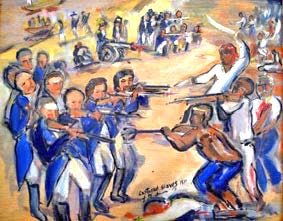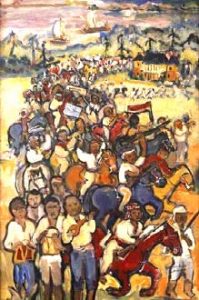Juneteenth Holiday here ♦ History of the Fight Against Us Slavery here ♦

The 1811 German Coast Uprising, led by Charles Deslondes, previously enslaved in Haiti, was the biggest revolt of enslaved people in US history.
New Juneteenth Holiday: US Rulers Try to Camouflage Their Racist System. Let’s Celebrate Workers’ Struggles for Liberation
USA, June 19—About 1.8 million people spent the brand-new Juneteenth “National Independence Day” holiday behind bars.
Juneteenth commemorates June 19, 1865, the day that Black and white US troops arrived in Galveston, Texas to forcibly suppress the last resistance of the enslavers.
The formerly enslaved people didn’t need to be told they were legally free. “We knowed what was goin’ on,” remembered freedman Felix Haywood. “We all felt like heroes and nobody had made us that way but ourselves.”
But for most the new “freedom” was debt slavery (sharecropping). It was prison labor (chain gangs). At best it was wage slavery for capitalist bosses. The enslavers’ whips and chains and the guns of Pinkerton strikebreakers reappeared as today’s racist police and prisons.
Many of today’s 1.8 million prisoners are locked up under the 1994 “Violent Crime Control and Law Enforcement Act.” This federal law escalated the “war on drugs” into a war on Black and Brown families. Then-Senator Biden, a key sponsor, bragged that liberal Democrats fought for “125,000 new state prison cells.”
Vice-President Kamala Harris helped lock up many of the 36,000 Black people now in California prisons. Her long career as a criminal prosecutor began in the 1990s and continued when she became the State Attorney-General.
Forced labor is still legal. The 13th amendment to the US Constitution prohibits slavery and involuntary servitude “except as a punishment for crime whereof the party shall have been duly convicted.”
During the Covid pandemic, women imprisoned in Chino, California sewed masks for 12 hours a day – but weren’t allowed to wear them! Refusing, they were told, would spoil their chances of release. Prisoners got as little as 8 cents an hour for high-risk jobs like cleaning communal showers and prison hospital Covid units.
The Californian Prison Industry Authority oversees 7000 incarcerated workers on its industrial plantations. These workers, mainly Black and Latinx, created $23.7 million in value in 2019 in fabric manufactures and another $16.9 million making furniture.
California prisoners are front-line fighters against deadly wildfires. The most skilled get less than $2/hour. Their prison records will exclude them from firefighting jobs when they get out.
Capitalism itself is another form of forced labor: wage slavery. We’re forced to work for capitalist bosses, on their terms, to avoid eviction or starvation.
Many anti-racist people celebrated Juneteenth long before the US ruling class coopted their holiday in a performance designed to build patriotism. It’s a cynical effort to channel anti-racist activists into elections and “national service.”
The rulers’ fight against China will require Black and Latinx youth, especially, who are willing to kill and die for the racist US empire. It’s no coincidence that Juneteenth celebrates US troops allegedly telling Black people they were “free.” The big lie is that the US military fights for “democracy.”
The masses need to liberate ourselves from all forms of capitalist slavery. We can’t wait for someone else to “free” us. We need communist revolution to end wage slavery, the material basis of racism today.
We need to mobilize for a communist society that enables us to contribute our labor to create the goods and services our international family needs. That ends the conditions that lead to anti-social behavior. Deals with problems cooperatively and collectively. Tears down the prisons. Disbands the police.
We celebrate the struggle of the masses toward this goal.
From the Haitian revolution of 1791 –1804 to the India mutiny and rebellion of 1857–59. From the Paris Commune of 1871 to the Bolshevik Revolution of 1917.
From the Chinese Cultural Revolution of the 1960s to the struggles against South African Apartheid and US imperialism in Central America in the 1980s
We learn from all these class struggles and many more, from their mistakes and from their advances. We learn how to build a bigger, stronger, and ultimately victorious communist movement.
One key lesson is that soldiers and sailors must join other workers and youth to help liberate our class. Not by following the orders of “democratic” rulers but by turning the guns around and destroying them.

Ending Slavery in the US: Resistance, Rebellion, Armed Struggle
Over twelve million children and adults, kidnapped from their African homes. Suffering the horrific “middle passage” across the Atlantic in European-owned ships. On one ship in ten, enslaved people resisted. Some defiantly chose suicide. Others organized full-scale mutinies.
The survivors were forced to labor in the Americas. Their children and most descendants were born into slavery. The English colonies, north and south, were built on their whipped and sweated backs starting in 1619. Their racialized class structure and legal systems defined American society.
The 1789 US Constitution counted each enslaved human as 3/5 of a person. Still, they resisted and rebelled.
They escaped and helped others to flee. They preserved and adapted diverse African cultures to their conditions of exploitation. They created an African-American heritage. Free Black people organized schools, churches, and more.
Capitalist rulers outlawed the overseas trade in human bodies in 1808. But older plantations exported enslaved children (often resulting from rape by their mothers’ enslavers) to the newly colonized west.
By 1840, over 2.5 million enslaved Black people formed 15% of the nation’s population. As “human capital” they were more valuable than all the industrial and transportation capital of the US. Their unpaid, coerced labor would make the US a world power.
Enslaved people responded to torturous oppression with larger and more violent uprisings. The terrified class of enslavers repressed them even more brutally.
Increasingly, free Black and White people defied institutionalized racism. They organized massively to abolish slavery. They included German and other immigrant workers fleeing the failed 1848 European revolutions.
Even radical abolitionists—including communists—fought to reform, not to overthrow, racist US capitalism.
Meanwhile, the economy developed unevenly between the industrializing North and plantation South. The struggle sharpened into a Civil War between their respective capitalists. Politicians like Lincoln tried, unsuccessfully, to separate this conflict from slavery.
Lincoln’s 1863 “Emancipation Proclamation” supposedly ended slavery only in Secessionist states, which his government didn’t control. But desperate northern capitalists had to mobilize and arm Black troops to help win the war. Then they could no longer avoid full legal abolition.
The 13th amendment to the US Constitution (ratified in 1865) outlawed slavery and involuntary servitude (except of prisoners) at least in theory.
Read our pamphlet:
TO END RACISM, MOBILIZE THE MASSES FOR COMMUNISM
available here


